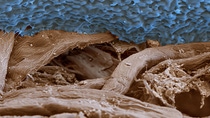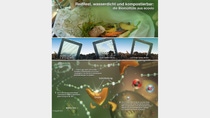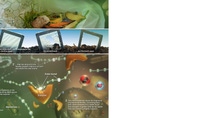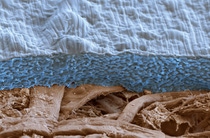Media
Tear-resistent waste bags for compost
The biodegradable plastic ecovio functions under real-world conditions.

Leftover lettuce, old bunches of flowers, potato peelings, coffee grounds: the average kitchen generates lots of organic waste. This can be turned into nutrient-rich compost in an industrial composting plant, but only if it is collected separately in advance – and that can be a bothersome and unhygienic task. Throw the leftovers straight into the bin and you will be confronted with a foul-smelling residue after emptying it. Lining the bin with a paper bag means liquid soaks through, the paper tears. This dilemma results in large quantities of compostable material ending up in the normal rubbish and subsequently being incinerated, using lots of energy in the process. Alternatively, biodegradable waste is disposed of in regular plastic bags, which must be painstakingly removed at the composting plant.
BASF has a solution to this problem: the compostable plastic ecovio® FS. In an industrial composting plant, this innovative material biodegrades within four weeks. Bin liners made from ecovio FS are strong and tear-resistant, even if the waste inside is wet. Liquid from tea bags or fruit leftovers does not seep through – reducing unpleasant odours and putting an end to laborious bin-scrubbing. Once full, the bag can simply be put out for collection with its contents.
The plastic’s properties first underwent extensive investigation in pilot projects at composting plants in Germany, Canada and Australia. But would the new compost bags pass the test when used on a large scale? To find out, BASF and its project partners examined the bags under real-world conditions. The study took place in Bad Dürkheim in the German state of Rhineland-Palatinate, from April to June 2011. Around 65,000 households each received ten ecovio FS bio-waste bags free of charge, and could buy more if needed. Consultancy IBK-Solutions GmbH was responsible for analyzing the compost. “The results were very positive,” says Erhard Freunscht, the Bad Dürkheim council member responsible for waste management. “Residents really took to the new bin liners, as was clear from the number of bags put out for collection. And after around three weeks, the bags had biodegraded – a complete success from our point of view.”

The key to ecovio FS’s outstanding compostability lies in its composition. The material comprises a partly petroleum-based, compostable plastic called ecoflex® FS, and polylactic acid made from corn starch. Polylactic acid, which is derived solely from renewable raw materials, tends to be brittle in its pure state. But when combined with ecoflex, a flexible plastic is created that can be used to manufacture a variety of products, including bin liners. In the controlled conditions of an industrial composting plant – high temperature and humidity, defined oxygen levels – microorganisms such as fungi and bacteria break the plastic down into water, carbon dioxide and biomass. In other words, they transform the bag and the bio-waste into valuable compost.
“Both components of ecovio – ecoflex and polylactic acid – are biodegradable,” explains Professor Andreas Künkel, Head of Research for Biopolymers at BASF. “For a material to be biodegradable, it is unimportant whether the feedstock is plant- or petroleum-based. What matters is the structure of the molecules. Because this synthetic polymer has been engineered for outstanding biodegradability, microorganisms can easily digest it.” ecovio FS’s superior biodegradable properties are recognized internationally, and it conforms to all relevant standards for compostable and biodegradable plastics in Europe, North America and Asia.
Bio-waste bin liners are by no means the only application. Paper cups can be covered with a thin layer of ecovio FS, making them both waterproof and compostable. The same applies to shrink films for drink bottle packaging. And not only bin liners but also shopping bags can be manufactured from ecovio. Agriculture, too, stands to benefit: by using biodegradable mulch films for their crops instead of conventional polyethylene film, farmers can simply plough it into the ground instead of painstakingly collecting it after the harvest.
International demand for biodegradable plastics is on the rise, with experts estimating an annual market growth of around 20 percent in the next few years. And BASF, a leading manufacturer of bioplastics, has significantly expanded its ecoflex and ecovio production capacity to keep pace. In future these plastics should make organic waste collection much easier – so more ends up as compost and less in landfill.


The Info Box
What are bioplastics?
The term “bioplastics” describes two groups of products – “bio-based” and “biodegradable” plastics.
Biobased plastics are made either wholly or partly from renewable raw materials and include polylactic acid, polyhydroxyalkanoates, starches, cellulose, chitin and gelatine. Biobased plastics can also be biodegradable – but this is not always the case. Nonbiodegradable biobased materials include biocomposites and composite materials made from wood and plastic.
Biodegradable plastic: Special bacteria release enzymes that break down the material’s long polymer chains into small parts that the bacteria subsequently digest and turn into water, carbon dioxide and biomass. To be designated biodegradable in line with the European standard DIN EN 13432, at least 90 percent of the material must have decomposed within 180 days under controlled conditions – high temperature and humidity, and defined oxygen levels. Once these standards are met, the product may display the seedling logo signifying compostability. Biodegradable plastics do not have to be made from renewable raw materials; they can also be petroleum-based. The raw material is unimportant; what matters is the chemical structure of the plastic.
When is using bio-based and/or biodegradable plastic a good idea?
There are no clear-cut advantages or disadvantages to using fossil-based or renewable raw materials per se. It is best to decide on a case-by-case basis, taking environmental concerns, cost-effectiveness and social impact over the entire product life cycle into account. BASF’s Eco-Efficiency Analysis has shown time and again that bio-based plastics are not always more eco-efficient than their petrochemical-based counterparts. If relatively little water and fertiliser are required, and transportation routes are short, using plant-based raw materials can be best for the environment. But if a large amount of energy is needed to process the materials, this beneficial effect can soon be reversed. Bio-degradable plastics are not necessarily more eco-friendly than other plastics. But for certain applications, they are the best solution – such as mulch films for agriculture, compostable food packaging or shopping bags. The latter have been available at discount supermarket Aldi Süd for the past few years: shoppers can use them a number of times before reusing them at home as compostable bin liners.


